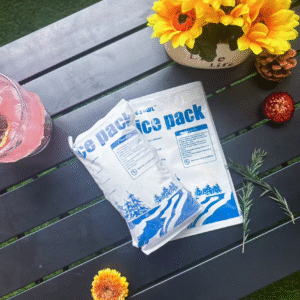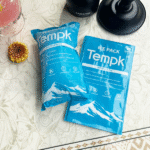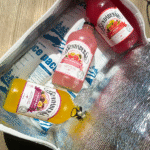When shipping temperature-sensitive products in 2025, using dry ice packs is an essential method to ensure your goods remain within their required temperature range. Dry ice allows for effective temperature control during transit, preventing spoilage and maintaining the quality of perishable items. This article provides comprehensive insights into using dry ice in cold chain logistics, einschließlich Best Practices, Vorschriften, and the latest trends.

-
Was ist Trockeneis, und wie funktioniert das beim Versand??
-
How to properly use dry ice packs for shipping?
-
What are the best practices for maintaining the right temperature during transit?
Was ist Trockeneis, and How Does it Work for Shipping?
Trockeneis ist gefrorenes Kohlendioxid (Co₂) and is widely used in the shipping of temperature-sensitive goods. Im Gegensatz zu normalem Eis, which melts and leaves moisture behind, Trockeneis untermauert direkt in Gas, hinterlässt keine Flüssigkeitsrückstände. This makes dry ice an ideal cooling agent for maintaining freezing temperatures during transit.
Why Dry Ice is Essential for Cold Chain Shipping:
-
Verlängerte Kühldauer: Trockeneis dauert länger als traditionelles Eis, providing up to 48 Stunden der Kühlung, depending on the shipment size and packaging conditions.
-
No Moisture: As dry ice turns into gas, it prevents the water damage that could otherwise affect perishable items.
-
Kostengünstig: Dry ice is a more affordable option compared to refrigerated containers, especially for shorter shipping distances or smaller shipments.
Wie man es richtig verwendet Trockeneisbeutel für den Versand?
1. Berechnen Sie den Bedarf an Trockeneis
The amount of dry ice needed depends on factors such as the weight of the shipment and the duration of transit. Eine allgemeine Regel ist die Verwendung 5 Zu 10 Pfund Trockeneis pro 24 Std. of shipping time for items weighing up to 12.5 Pfund.
Key Tips:
-
Für short-distance shipments, use a lower amount of dry ice (Z.B., 5 lbs pro 24 Std.).
-
Für längere Sendungen, ensure that the cooling is sufficient by increasing dry ice quantity and using better insulation.
2. Verwenden Sie die richtige Verpackung
Dry ice must be placed inside well-insulated containers that minimize heat transfer. Gemeinsame Materialien umfassen:
-
Styropor Und Mylar-Taschen, which offer excellent insulation.
-
Kühltaschen that are designed to handle the sublimation of dry ice without compromising the integrity of the shipment.
Beste Practice: Ensure that the dry ice is positioned at the top of the shipment to allow the cold air to descend through the package, maintaining an even temperature distribution.
What Are the Best Practices for Maintaining the Right Temperature During Transit?
1. Temperaturüberwachung
For highly sensitive shipments, it is essential to track the internal temperature throughout the transit. Using temperature monitoring devices will help ensure that the goods remain within the desired range.
-
Real-Time Temperature Tracking: Consider including a Datenlogger that tracks temperature changes in real-time and provides alerts if there are any deviations.
2. Pakete richtig beschriften
All shipments containing dry ice should be clearly labeled with the proper identification:
-
„Kohlendioxid-Feststoff“ label for clear identification.
-
Und 1845 label to comply with shipping regulations.
-
Der Nettogewicht of the dry ice in kilograms must be included.
This ensures that handlers are aware of the contents and can take the proper safety precautions.
How to Optimize Your Shipping Processes with Dry Ice?
To further improve your cold chain logistics, here are some advanced strategies for optimizing dry ice usage:
-
Analysieren Sie historische Versanddaten
Review past shipping data to determine the amount of dry ice used in different conditions. This helps improve future efficiency and reduce wastage. -
Use Temperature-Controlled Containers
Für längere Versanddauern, entscheiden Sie sich dafür thermal reflective containers that can prolong the effectiveness of dry ice, ensuring the cold chain is maintained. -
Automate Shipping and Monitoring
Leverage AI-powered logistics platforms to predict shipping conditions and calculate the optimal dry ice amount required for each shipment. Automation can streamline the process, minimize human error, and ensure that your goods stay at the right temperature.
| Versandfaktor | Empfohlene Praxis | Warum ist es wichtig |
|---|---|---|
| Menge Trockeneis | Verwenden Sie 5–10 Pfund pro 24 Stunden des Versands | Ensures consistent cooling without wastage |
| Verpackung | Use insulated containers like Styrofoam | Retains cold and extends dry ice longevity |
| Temperaturüberwachung | Include devices to track temperature | Prevents temperature excursions and spoilage |
Trockeneisschifffahrt: Tips for Safe and Efficient Use
Sicheres Handling von Trockeneis
Trockeneis ist sicher, wenn er mit Sorgfalt behandelt wird. Immer benutzen Isolierte Handschuhe and avoid direct skin contact to prevent frostbite. Zusätzlich, ensure dry ice is stored in gut belüftete Räume to allow the gas to dissipate safely.
Planning for Safe Disposal
Als Trockeneis untermüßt Gas, it must be handled correctly to avoid the build-up of carbon dioxide. Always ensure dry ice is disposed of in a gut belüfteter Gebiet, far from enclosed spaces.
2025 Trends bei Trockeneis-Versandlösungen
The cold chain industry is evolving rapidly with a focus on Nachhaltigkeit Und Technologie.
New Dry Ice Technologies:
-
Intelligentere Verpackungen: Fortschritte in intelligente Verpackungen are enabling shipments to self-regulate temperature, ensuring consistent conditions throughout transit.
-
KI-gesteuerte Logistik: Artificial intelligence is used to predict environmental factors, Optimieren Sie den Trockeneisverbrauch, und Abfall reduzieren.
Nachhaltige Praktiken:
Eco-friendly packaging materials, wie zum Beispiel biodegradable liners Und Mehrwegbehälter, are becoming increasingly popular, Reduzierung der Umweltauswirkungen.
Häufig gestellte Fragen
What is the ideal amount of dry ice for shipping seafood?
To maintain the freshness of seafood, use 1–2 pounds of dry ice per 24–48 hours of shipping time. Adjust based on transit conditions.
Can dry ice be used for shipping personal care products?
Ja, dry ice can be used for shipping personal care items, particularly those that need to remain cool but not frozen. Use proper insulation and avoid direct contact with the products.
Zusammenfassung und Empfehlungen
Dry ice remains an essential tool for cold chain logistics, providing reliable cooling without moisture damage. Indem Sie Best Practices befolgen, such as proper packaging, Temperaturüberwachung, und Etikettierung, businesses can ensure the safe and efficient transportation of temperature-sensitive goods.
Umsetzbare Vorschläge:
-
Assess your shipping needs and determine which products require dry ice.
-
Train staff on safe handling procedures and regulatory compliance.
-
Erwägen Sie eine Integration intelligente Verpackungen technologies to improve efficiency and reduce costs.
Über Tempk
Und Tempk, Wir spezialisieren uns auf Fortgeschrittene Kaltkettenlösungen für Versandtemperaturenempfindlichkeitsgüter. Unsere innovativen Produkte, einschließlich Trockeneisbeutel, Phasenveränderungsmaterial, und isolierte Behälter, ensure that your shipments arrive safely, rechtzeitig, und in optimalem Zustand.
Aufruf zum Handeln: Reach out today for tailored cold chain solutions, and optimize your shipping processes with our reliable dry ice packs and cutting-edge logistics technologies.























